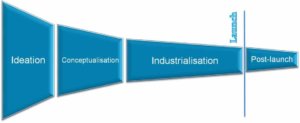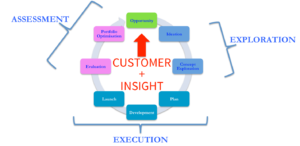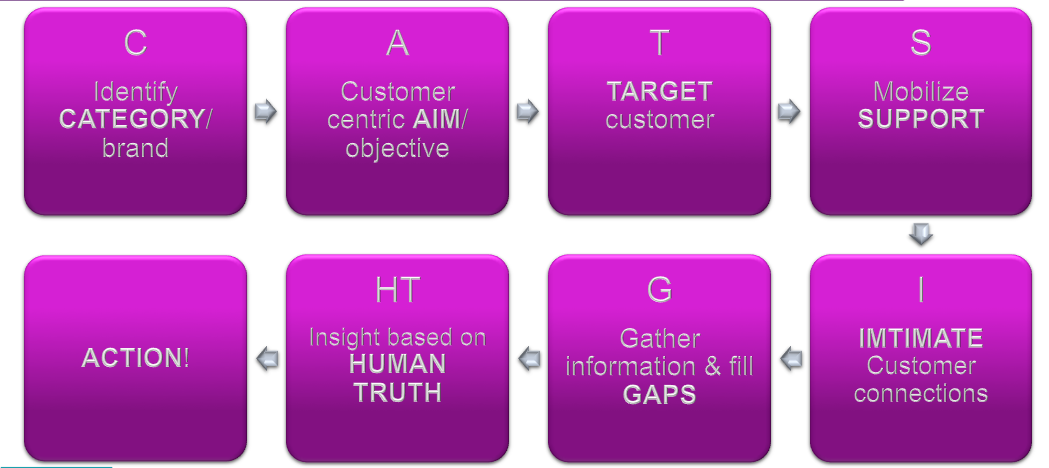One of the most frequent questions I get asked by my clients is how they can improve their innovation.
Whether they are large or small, global or local, they all want to their new products and services to be more successful. And the answer I give them to this question every single time is simple; start with the customer!
Many companies create great new products and services – from their perspective at least – but they fail miserably! They then ask me if I can help them to improve their innovations and identify why this happened. Of course, I do help them, but I also suggest that next time it would be better if they called me before they started innovating! In a failure situation, it is almost always due to an outdated innovation process in which the customer has not been involved.
I know it can be difficult to innovate in this new age of technology, but it remains vital for growth. And Switzerland remains one of the most innovative countries in the world. In both the GII (WIPO Global Innovation Index and Bloomberg Index Switzerland appears in the top five. I think this is why I regularly get invited to run workshops on the topic around the world.
China is an innovation hot-house
China, excluding Hong Kong, joined the top 20 most innovative countries in the WIPO global innovation index for the first time in 2018. This is because they no longer rely on cost-effective manufacturing alone. They also applied for more patents than the next two countries, the United States and Japan, combined! This clearly shows that China is improving ideation as well as their innovation process. But they know they must do even more. To become a truly competitive nation, they have to better understand their target customers, especially their growing middle and higher-income residents, who continue to prefer primarily imported Western brands.
Let me share with you a few of the ideas that I spoke about during my recent visit there. They may also deliver more successful innovation for your organisation too.
Innovation is essential
Most companies innovate from an internal technical and skills-based foundation. It doesn’t usually work very well, if at all. In fact, according to Nielsen, IRI, Fortune and many others, it is estimated that between 85% and 95% of new consumer products in the US fail. In Europe, it’s just as bad, with only 25% of new consumer products being still available on shelf just twelve months after launch! And less than half that number by the end of the second year.
With such disastrous results, you might wonder why companies continue to innovate. Well there are three main reasons why they do:
- It keeps brands fresh. Brands which innovate have something new to share with current and potential clients. We have come to expect it. What excites today, is normal tomorrow and then just boring after that. We have gotten accustomed to regular updates and constant new choices.
- It encourages switching. If brands and options remain the same, people would only switch if they became dissatisfied and the cost of switching was low. Since product performances are so similar in many categories today, new variants and offers suggest differentiation. The brand appears more vibrant and people like that.
- It revives brands through excitement and buzz. In today’s connected world, this is vital. People learn about brands as much from friends and family as through advertising. And they trust the former more than the latter, even if some of these “friends” are virtual ones they’ve never met. According to Nielsen’s report ” Global Trust in Advertising” more than eight-in-10 global respondents (83%) say they trust the recommendations of friends and family, and two-thirds (66%) others’ opinions posted online.
Renovate your innovation process

It still surprises me that companies continue to use the same innovation process as they’ve always done, when their failure rate remains so high. Today’s digital environment needs a whole new approach.
The old process often looks something like the diagram on the right. Is that what yours looks like? In fact, is your process a funnel? If so, then you’re facing at least two problems:
1. That it is a funnel. This process is linear, with a beginning and an end. It assumes that there is only one “winner” from all the ideation and brainstorming. And it also supposes that only one concept developed from that “winning” idea will succeed.
But what if all your ideas are great? You would be throwing away all but one of them! Or suppose that they are all “losers” and you launch the least “awful” amongst them? There must be a better way, no?
Even IDEO’s iterative process still assumes “winners”, because they quickly move from brainstorming to prototyping and testing with customers. At least they do suggest co-creating with customers, which is a positive element of their process and it is great fun to do – from my own experiences. But as I said, there is a better way.
2. That it doesn’t include the customer. How can you have any chance of innovating for your customers if you don’t include them? You are relying on your own perspective to make choices. Are you the typical consumer for whom you are innovating? Probably not. So why are you taking decisions based on your own opinions and those of your colleagues? They’re pretty irrelevant if you think about it!

The second diagram on the right is the type of NPD process that I encourage my clients to use. It is, of course, always adapted to their own specific needs and based upon their current process to speed adoption and change.
The major difference from most current innovation processes that my clients have shared with me, is that it is a virtuous circle. It starts and ends with opportunity identification, in other words with the customer and insight. This, of course, means that we must know and understand our customers deeply.
Know your target audience intimately
We all think we know our customers, don’t we? But in most cases this is not strictly true. At least, we don’t know them as deeply as we should or could. One of the quickest roads to improving ideation and innovation is to know for whom you are innovating.
The first thing I ask my clients to complete, and regular readers will know it well, is the 4W™ Template of the “who”, “what”, where” and most importantly of all, the “why” of their target audience. Often times they struggle with the last “W”. If you want to try it for yourself, check out our detailed post on it “How well do you know your customers?”
Even with this template completed, you still have to go further. Optimal understanding comes from regular connection. Our customers are changing – fast – so we need to keep our fingers on the pulse of the market. Yesterday’s information is not much use to manage today’s brands or innovate for tomorrow.
During my talk at Shanghai’s ECUST University, someone asked me how we can be better prepared for the future. I love the question, as it enables me to speak about another of my passions, that of scenario planning.
Change happens, and especially rapidly in fast developing markets such as China. My recommendation to the student was to not rely on trends alone. They are uncompetitive. To gain an advantage over the competition, you need to develop trends into plausible future scenarios. If you are interested in learning more, then do check out our post “10 Steps & 5 Success Factors to Ensure your Business is Ready for Anything“.
Knowing why your customers do what they do, buy what they buy and consume what they consume, and then watching and listening to them to understand even better, will put you in the best possible position for improving ideation and innovation. But there’s still more you can do.
Increase your external partnerships
As mentioned above, many companies still rely on their own technology and skills to innovate. However, while technology can certainly help deliver improved benefits, it is usually not sufficient. In many areas, companies need to collaborate with others who are more specialised in certain areas.
Joint ventures and partnerships are also useful for developing new products and services more quickly. You don’t need to build the needed skills internally and you can rely on the immediate support of external experts. Whether you team up with another corporation or a university is up to you, as long as you recognise your need for additional support. If you rely totally on your internal knowledge for improving ideation and innovation, you are unlikely to find those breakthrough ideas most companies are searching for.
There are many examples of large consumer goods companies partnering with external experts. The Laboratoires Innéov was a joint venture in nutritional cosmetics between L’Oréal and Nestlé, although the relationship ended in 2015. Nestle also created Cereal Partners Worldwide as a joint venture with General Mills and Beverage Partners Worldwide with Coca-Cola.
Procter & Gamble and Teva Pharmaceutical Industries announced the creation of a joint venture in consumer healthcare in 2011. The newly named PGT Healthcare partnership with president Tom Finn has since negotiated tens of JV’s, partnerships and strategic alliances.
Expand your business model
Another external lever from which more and more companies are benefiting today is a change in their business model. Take the food industry. It is moving from basic nutrition into health and wellness, and could become a direct competitor to the pharmaceutical industry as it develops more nutraceuticals.
Pharma, on the other hand, is moving from sickness to wellness, from treatments to prevention.
And what about telecoms? They now make almost as much money selling geo-localisation data as they do from providing communication services.
Or how about Google moving into cars, solar panels and most recently travel with its Trips App? Through the analysis of their customers’ searches, Google can identify those of us who are looking to travel, those interested in buying a new car or in using taxi services. Google knows more about us today than we know ourselves! And that is both exciting and frightening.
Harness emotional benefits
Companies which succeed at innovation know that it is the emotional benefits of their product or service that matters, often more so than the functional ones.
Apple used to be a great innovator. In the past few years, I feel they have been relying too much on their technical expertise. The launches of their iPhone 7, 8 and X and the new Mac Book laptops were all less successful than their previous launches. While none are real flops, they failed to ignite excitement in their potential customers.
There have been numerous posts on why Apple is failing at innovating today. One article in the HBR by Steve Blank stated that both Steve Jobs and Bill Gates
“… suggested execution executives as their successors. They confused world-class execution with the passion for product and customers, and market insight. Yet history has shown us that these two talents are not the same. For long-term survival in markets that change rapidly, one is far more important than the other.”
Another article in Business Insider by Julie Bort concludes by saying
“Microsoft is now officially more innovative than Apple”
based upon Tweets of the events. But Microsoft too failed when Bill Gates handed the company leadership over to Steve Ballmer. For 14 years Ballmer successfully ran the business from a financial perspective. He tripled sales and doubled profits. But he didn’t set the company up for long-term survival. In early 2014, Satya Nadella took over and made some radical changes which focused the company on mobile and the cloud (Azure). This freed Microsoft to become more innovative again and the result is already showing.
Develop insights as a company
Some managers think that insight is just another word for market research. They’re wrong, but perhaps you too see it in this way?
Market research is a great source of information, but for insight, you have to integrate multiple sources of information. It is rare for a single project to provide a deep insight. This comes from truly understanding the customer and that takes time. It takes data and information, turned into knowledge and then understanding to develop real insight.

The full development process, such as the example given on the right, takes time and people, ideally with differing perspectives. It takes a detailed understanding of the target audience, their needs and desires so that you can resonate emotionally with them.
Many organisations work with human truths to help in identifying a concept that will resonate emotionally. These are usually based on basic human needs, which cut across cultures. This makes them particularly useful for regional and global brands.
During my different talks, I share many examples and case studies, but one which my audiences usually find particularly fascinating is the insight both Unilever’s Omo and Nestle’s Nido have used. The insight is based on the human truth that “All parents want their children to grow up happy and healthy”. The insight they then developed, which is as equally relevant for washing powder as it is for infant formula is “I want my child to experience everything life has to offer, even if it means getting dirty”. What is particularly interesting in this example is that both companies have been able to use the same human truth and insight but make it relevant for each of their categories.
My recommendation, therefore, if you are struggling to develop insight, is to analyse your competitors or the brands targeting a similar audience. If you can identify on what human truth and insight their message is based, you may be able to use it too.
Conclusions
These are just a few of the many ideas which I shared with enthusiastic audiences wherever I speak about innovation around the world. It is clear that both entrepreneurs and corporate executives in China are particularly keen to improve their innovation. They are also thirsty for support in further improving their ideation. For this reason, I believe they will continue to top the nations in patent applications for many years to come.
Therefore, it is vital that we supposed “developed” nations support our entrepreneurs and creative executives to stay in the race. Unless we do so, we could see China dominate new products and services in the future, as they have dominated manufacturing in the past.
What do you think? I would love to hear your thoughts on the race for innovation.












